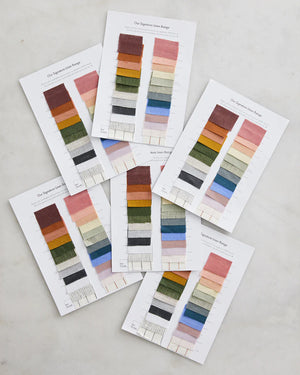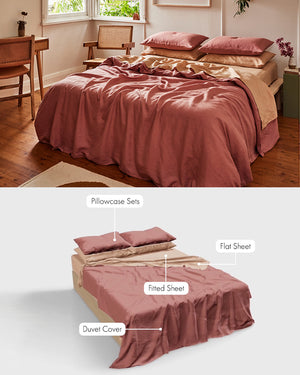A Practical Guide to Composting in a Small Apartment
Every time you throw away your banana peel, apple core, egg shells, or meat trimmings, just think: that’s a valuable piece of food that could be recycled via composting.
The problem is, a lot of people living in small apartments avoid composting because there’s a common misconception it may make your place smell a little... funky. However, the truth is that it’s possible to set up a composting system without stinking up your home - and you don’t even need an expansive backyard to reap the benefits.
According to Audrey Gater from Seed & Sprout, there are two basic things you need to consider before composting at home. Firstly, what system best suits your area?
“There are a few different types available on the market that suit a number of garden spaces,” Gater tells Bed Threads Journal. “Some systems go straight into the ground and are ideal if you're looking for something more discreet. Alternatively, there are compost bins that sit above ground and even tumbler compost bins that mix and aerate your waste by rotating. If you don’t have a tumbler system, we’d recommend grabbing yourself an aeration tool to speed up the composting time.”
You also need to take into consideration what size will work best for you and your space. “It's worth doing some research before buying to find out what's going to work for your individual needs. If you generate a lot of organic waste then you’ll want to consider a bigger system.”
For those with limited outdoor space, there are various systems available that will fit on a balcony, or you can also opt for an indoor worm farm, which will turn your food scraps into compost.
The second most important thing to consider is: how will you be collecting your scraps? A lot of people add their scraps to their general waste bin with the good intention of composting it however, time passes and it ends up in landfill. To avoid this problem, you’ll want to invest in a separate good quality compost bin like Seed & Sprout’s Mini Compost Bin.
“They're odor neutralizing and have a handle that makes it easy to empty scraps. Plus, they're super easy to clean,” Gater says.
Be sure to place the bin in a visible spot to remind you - and everyone else - to collect scraps.
4 tips for composting in a small apartment
Now you’re acquainted with the basics of composting, here are Gater’s top tips for turning your little apartment into a valuable composting system you’ll actually want to use - and keep.
1. Look at your food waste
It's worth looking at your food waste in general before starting your composting journey. Are you throwing away veggie or fruit scraps that you could either save later for a stock, or actually eat? Many of us throw away cauliflower leaves and broccoli stalks that are completely edible.
There are so many great recipes online for using up your leftovers, so get creative and then add any that you can't use into your compost.
2. Collect your food scraps
Collecting your food scraps doesn't have to be messy or smelly. We do recommend emptying your food scraps bin daily if you can, or every 2-3 days is fine.
If you’re going to donate your food scraps, you can freeze them in a compostable bin liner, which will stop any smells developing before you find time to give them away.
3. Add a compost bin to your balcony
If you're limited with your outdoor space, this doesn't mean you can't jump on the composting bandwagon. A number of smaller compost bins and worm farms can be stored on your balcony. Just make sure you choose a well-drained, flat, and easily accessible location.
If you’re considering a worm farm then be mindful that the worms don’t like to be much above 30 degrees, so check what kind of space you can offer them before investing.
4. Give your scraps away
If you're in an apartment with no outdoor space, consider giving your scraps away. Do a call out to your neighborhood to see if anyone is composting and looking for scraps as there’s a good chance there's someone close by who'd be happy to take them off your hands. Community gardens will usually take food scraps, too - just make sure you contact them before dropping them off.
We recommend reaching out to others in your apartment block to see if they'd like to donate their scraps, too. That way you can take it in turns dropping them off. You can also try connecting with neighbors or local farmers to see if they'd be willing to take your scraps. Try community Facebook groups or farmers markets.
A step-by-step guide to composting in a small apartment
So you've chosen your composting system, location and have started collecting food scraps - but now what? Here's a basic breakdown of how to compost at home, according to Gater. (Note: the below will vary depending on the system you use so use it as a general guide.)
Step 1: Collect brown materials, too
Composting systems are made up of two key components: green waste and brown waste. Green waste is your food scraps (the nitrogen group), and browns are your carbon group and include materials such as cardboard, leaves, paper, and so forth. The key to good compost is getting the right balance between the two.
Step 2: Start layering
You'll need a good carbon (brown) to nitrogen (green) ratio to get your compost going. Start with a layer of browns. You can then start alternating between green waste and brown waste, remembering to add about four times the amount of brown materials compared to green materials.
Step 3: Aeration
To help speed up the composting process, be sure to aerate your compost about once a week. There are plenty of tools available online to help you do this.
You'll also need to make sure your compost isn't too wet, or too dry. If it's too wet, add some more brown materials and if it's too dry, add some water. You want it to be moist but not soggy. If you'd like to rapidly speed up the process, you can add other elements such as compost worms that will eat their way through your food scraps - exiting their body as compost.
Step 4: Cover
You'll need to cover your compost so it's not over-exposed to elements. You can use anything you have to help retain moisture and heat - the two essentials for compost. Covering also prevents the compost from being over-watered by rain. The compost should be moist, but not soaked and sodden.
Step 5: Complete Compost
Every compost is different and depending on your system - and how much waste you produce - it can take anywhere from weeks to months to breakdown completely. You'll know it's ready when your compost is crumbly and dark. You can then use this in your garden or your indoor plants.
Audrey Gater is the Head of Marketing at Seed & Sprout. Follow them on Instagram @seedandsproutco.
Lead image courtesy of Seed & Sprout, featuring their Mini Compost Bin.
So you live in a small apartment? Here's how you can still have your very own luscious herb garden.




















